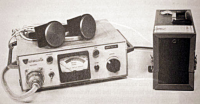








Defibrillation is a common treatment for life-threatening cardiac dysrhythmias, ventricular fibrillation and pulseless ventricular tachycardia. Defibrillation consists of delivering a therapeutic dose of electrical energy to the heart with a device called a defibrillator. This depolarizes a critical mass of the heart muscle, terminates the dysrhythmia and allows normal sinus rhythm to be reestablished by the body's natural pacemaker, in the sinoatrial node of the heart. Defibrillators can be external, transvenous, or implanted (implantable cardioverter-defibrillator), depending on the type of device used or needed. Some external units, known as automated external defibrillators (AEDs), automate the diagnosis of treatable rhythms, meaning that lay responders or bystanders are able to use them successfully with little or no training at all.
History
Defibrillation has long been recognized as a lifesaving procedure. One of the first reported incidents in which electricity was used for the resuscitation of an apparently dead individual occurred in England in 1774 when electric shocks applied to the thorax of a young girl reestablished her pulse. In the 1780s British surgeon Charles Kite invented a precursor of the modern defibrillation device. Later studies, including those conducted by Italian physician and physicist Luigi Galvani in the 1790s and by Italian physicist Carlo Matteucci in the 1840s, shed light on the electrical properties of animal tissues. In fact, Matteucci, in his studies of electricity detection in pigeons, was the first to detect an electrical current in the heart. Research performed in the following decades led to an improved understanding of the electrical features of heart rhythm.
In 1947 American physician Claude S. Beck, who had been investigating new techniques for defibrillation in humans, reported having successfully reestablished normal heart rhythm in a patient with ventricular fibrillation (irregular and uncoordinated contraction of the ventricle muscle fibres) during heart surgery. Beck’s defibrillation technique and device served as a prototype for the development of modern defibrillators. In the 1960s Polish-born American physician Michel Mirowski came up with an idea for the development of an automatic implantable cardioverter defibrillator, which could be used in patients affected by certain types of arrhythmia. The first ICD was implanted in a patient on Feb. 4, 1980.
Emergency personnel began being trained in defibrillation in the 1960s, and the first automated external defibrillator devices were clinically tested in the early 1980s. The first AEDs delivered strong shocks in a monophasic waveform and often required multiple shocks to reestablish heart rhythm. Later AEDs were refined to deliver shocks in a biphasic waveform, which, relative to monophasic shock, was found to be safer and more effective.